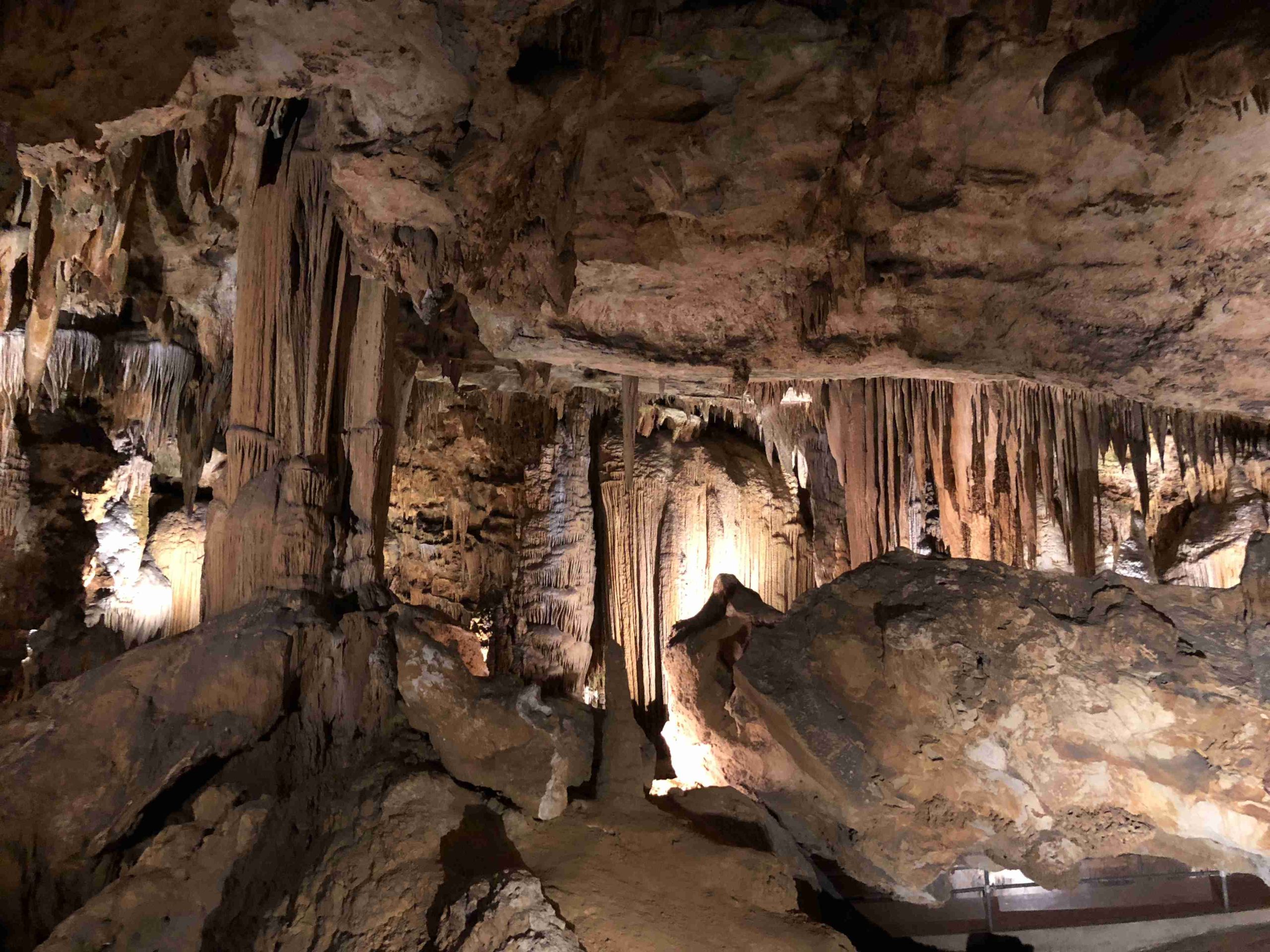Titania’s Veil in Luray Caverns is a stunning calcite formation known for its delicate, translucent appearance resembling a sheer veil. Located within the extensive network of Luray Caverns in Virginia, this pristine white calcite formation is a testament to the geological wonders hidden beneath the Earth’s surface. Discovered in 1878 along with the rest of Luray Caverns, Titania’s Veil continues to captivate visitors with its ethereal beauty and geological significance.
What is the Geological Composition of Titania’s Veil?

Titania’s Veil is primarily composed of calcite, a crystalline form of limestone. This mineral composition gives the formation its distinctive characteristics:
- Pure white color in its natural state
- Translucent appearance
- Delicate, sheet-like structure
The formation of Titania’s Veil is a result of centuries of mineral deposition, where calcium carbonate-rich water slowly dripped and flowed, leaving behind layers of calcite that built up over time.
How Was Titania’s Veil Discovered?

The discovery of Titania’s Veil is intertwined with the exploration of Luray Caverns:
- Date of Discovery: August 13, 1878
- Discoverers: Andrew Campbell, William Campbell, and Benton Stebbins
- Method of Discovery: Chance exploration after noticing a sinkhole with cool air
While the exact moment Titania’s Veil was first observed is not recorded, it was undoubtedly part of the awe-inspiring formations that greeted the initial explorers as they ventured deeper into the caverns.
What Makes Titania’s Veil Unique Among Cave Formations?
Titania’s Veil stands out for several reasons:
- Purity: Its pristine white color indicates an exceptionally pure calcite composition.
- Delicacy: The formation resembles a thin, translucent curtain, unlike more solid stalactites or stalagmites.
- Naming: Inspired by Shakespeare’s character Titania from ‘A Midsummer Night’s Dream’, suggesting its ethereal beauty.
- Preservation: Despite being over a century since its discovery, the formation remains well-preserved due to careful conservation efforts.
Where Exactly is Titania’s Veil Located Within Luray Caverns?
Titania’s Veil is situated:
- Within the main tour route of Luray Caverns
- Approximately 80 feet below the surface (the average depth of the caverns)
- Near other famous formations like the Double Column and Dream Lake
Visitors can access Titania’s Veil through the standard cavern tour, which follows well-lit, paved walkways designed for easy navigation.
What Are the Visiting Hours and Admission Prices for Seeing Titania’s Veil?
To view Titania’s Veil, visitors must enter Luray Caverns. Here’s the essential information:
| Category | Price |
|---|---|
| Adults | $34 |
| Seniors | $32 |
| Children (6-12) | $17 |
| Children (under 6) | Free |
- Operating Hours: Open every day of the year, including holidays
- Tour Duration: Approximately 1 hour
- Accessibility: Paved walkways suitable for most visitors
How Has Titania’s Veil Impacted Luray Caverns’ Popularity?
Titania’s Veil has contributed significantly to Luray Caverns’ reputation:
- Attraction Factor: Its unique appearance draws photographers and nature enthusiasts.
- Educational Value: Provides a visual example of calcite formations for geology students.
- Tourism Boost: Helps maintain Luray Caverns’ status as one of the most visited show caves in Eastern U.S.
- Conservation Awareness: Highlights the importance of preserving natural underground formations.
What Conservation Measures Protect Titania’s Veil?
To ensure the longevity of Titania’s Veil and other formations, Luray Caverns implements several protective measures:
- No-Touch Policy: Visitors are strictly prohibited from touching any formations.
- Climate Control: Maintaining consistent temperature and humidity levels within the caverns.
- Limited Access: Guided tours only, preventing unrestricted access to sensitive areas.
- Educational Programs: Informing visitors about the fragility of cave ecosystems.
How Does Titania’s Veil Compare to Other Formations in Luray Caverns?
While Titania’s Veil is remarkable, it’s part of a diverse array of formations within Luray Caverns:
- Giant’s Hall: Features massive columns and draperies
- Saracen’s Tent: Known for its striped appearance
- Dream Lake: A shallow pool with a perfect reflection
- Great Stalacpipe Organ: World’s largest musical instrument
Each formation offers a unique perspective on the caverns’ geological history and processes.
What Scientific Research Has Been Conducted on Titania’s Veil?
While specific research on Titania’s Veil is not widely published, studies on Luray Caverns have included:
- Geological surveys to understand the caverns’ formation
- Water quality assessments to monitor environmental impacts
- Microbiological studies of cave ecosystems
These studies contribute to our understanding of cave formations like Titania’s Veil and help inform conservation efforts.
How Can Visitors Best Photograph Titania’s Veil?
For those looking to capture the beauty of Titania’s Veil:
- Use a tripod for stability in low-light conditions
- Opt for a wide-angle lens to capture the formation’s context
- Experiment with different angles to highlight the veil-like texture
- Be mindful of cave lighting and adjust camera settings accordingly
- Respect photography guidelines set by Luray Caverns management
Remember, flash photography may be restricted to protect the cave environment.
Titania’s Veil in Luray Caverns remains a testament to the hidden wonders beneath our feet. Its delicate beauty and geological significance continue to inspire awe in visitors, reminding us of the intricate processes that shape our planet over millennia. As we marvel at this natural masterpiece, we’re also called to reflect on our role in preserving such fragile ecosystems for future generations to explore and admire.
References:
1. Wikipedia – Luray Caverns
2. Ashburn Magazine – Luray Caverns amazes visitors more than a century after its discovery
3. Luray Caverns Official Website – Explore

